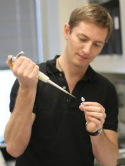The landscape of mouse meiotic double-strand break formation, processing, and repair Journal Article
| Authors: | Lange, J.; Yamada, S.; Tischfield, S. E.; Pan, J.; Kim, S.; Zhu, X.; Socci, N. D.; Jasin, M.; Keeney, S. |
| Article Title: | The landscape of mouse meiotic double-strand break formation, processing, and repair |
| Abstract: | Heritability and genome stability are shaped by meiotic recombination, which is initiated via hundreds of DNA double-strand breaks (DSBs). The distribution of DSBs throughout the genome is not random, but mechanisms molding this landscape remain poorly understood. Here, we exploit genome-wide maps of mouse DSBs at unprecedented nucleotide resolution to uncover previously invisible spatial features of recombination. At fine scale, we reveal a stereotyped hotspot structure—DSBs occur within narrow zones between methylated nucleosomes—and identify relationships between SPO11, chromatin, and the histone methyltransferase PRDM9. At large scale, DSB formation is suppressed on non-homologous portions of the sex chromosomes via the DSB-responsive kinase ATM, which also shapes the autosomal DSB landscape at multiple size scales. We also provide a genome-wide analysis of exonucleolytic DSB resection lengths and elucidate spatial relationships between DSBs and recombination products. Our results paint a comprehensive picture of features governing successive steps in mammalian meiotic recombination. © 2016 Elsevier Inc. |
| Keywords: | mouse; meiosis; dna damage; homologous recombination; dna repair; chromatin; resection; double-strand break; spo11; prdm9 |
| Journal Title: | Cell |
| Volume: | 167 |
| Issue: | 3 |
| ISSN: | 0092-8674 |
| Publisher: | Cell Press |
| Date Published: | 2016-10-20 |
| Start Page: | 695 |
| End Page: | 708.e16 |
| Language: | English |
| DOI: | 10.1016/j.cell.2016.09.035 |
| PROVIDER: | scopus |
| PMCID: | PMC5117687 |
| PUBMED: | 27745971 |
| DOI/URL: | |
| Notes: | Article -- Export Date: 6 December 2016 -- Source: Scopus |
Altmetric
Citation Impact
BMJ Impact Analytics
Related MSK Work











